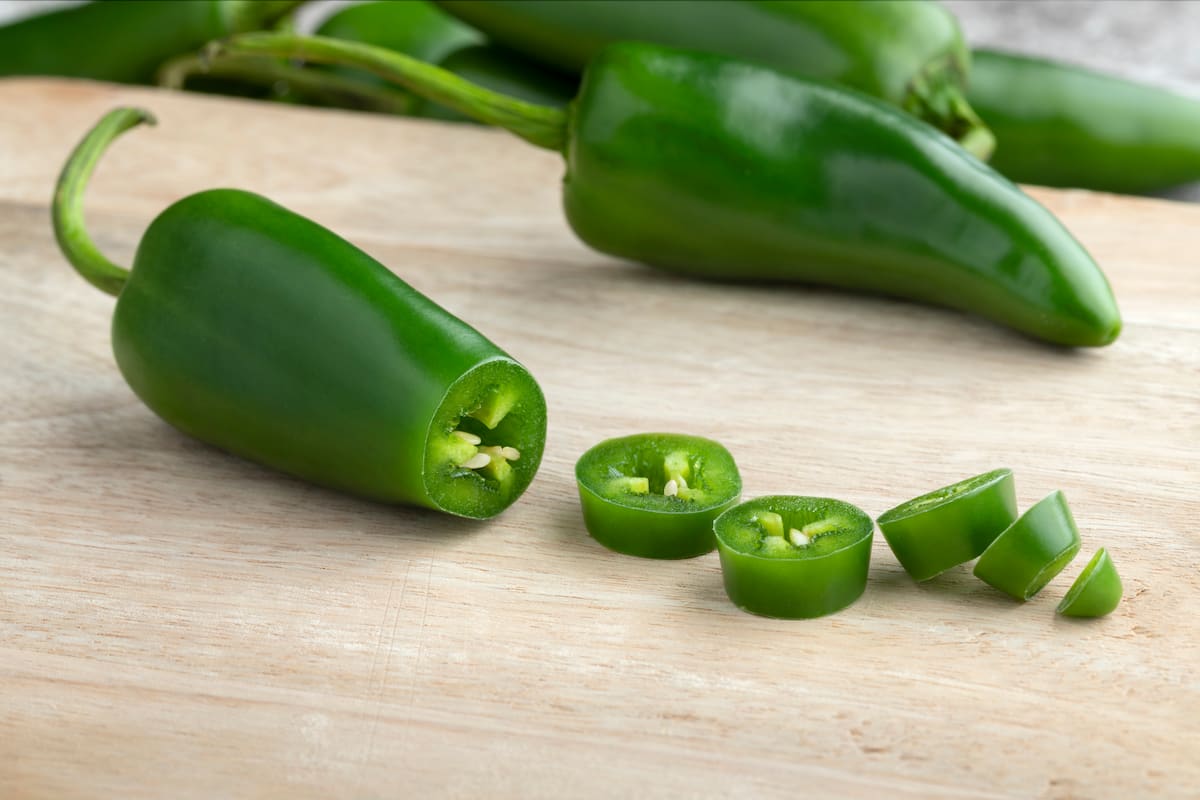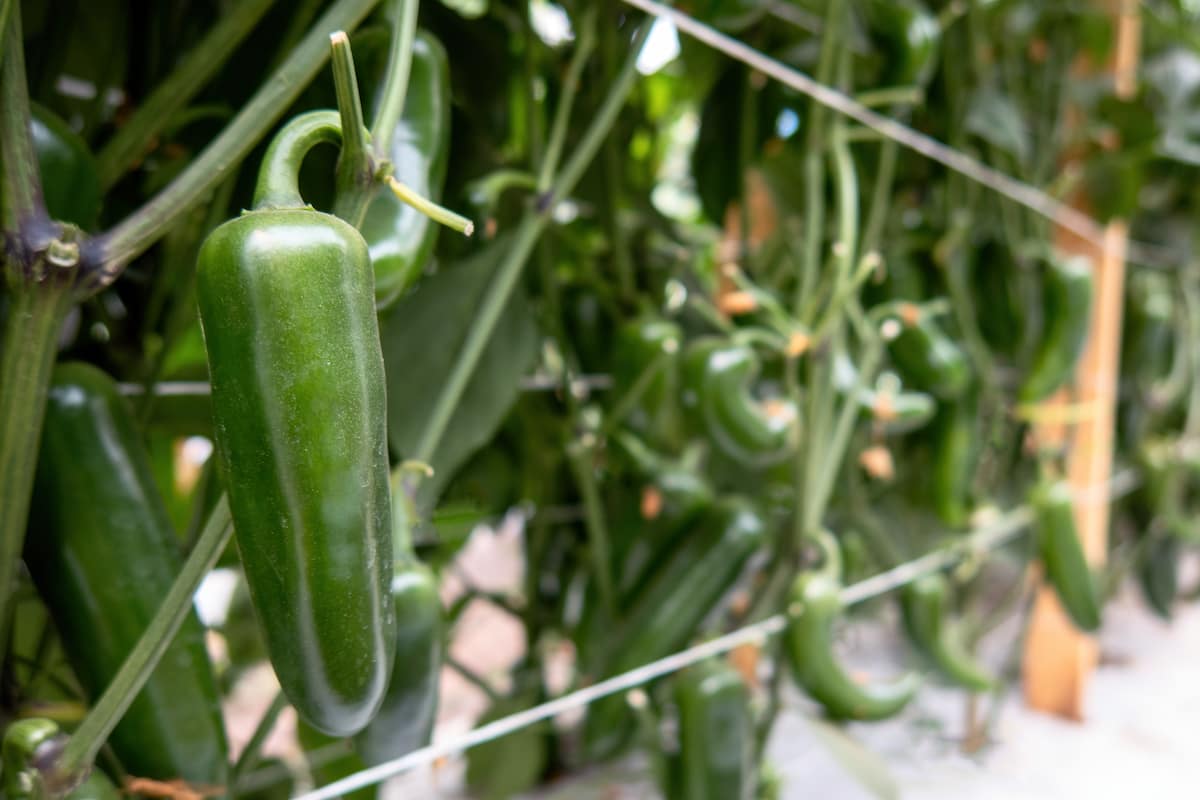Growing Jalapeno peppers is relatively easy – even if you’re a beginner gardener. Jalapeno pepper plants are easy to grow in containers and can be started from seed or transplanted from another plant.

How to Grow Jalapeno Peppers from Seed in Containers
Soil Requirement for Growing Jalapeno Peppers
When growing Jalapeno peppers, it is important to use well-draining soil. Peppers do not like to sit in wet soil, as this can lead to root rot. If you are unsure about the drainage of your soil, you can add some sand or perlite to help with drainage. You also want to ensure that your soil is rich in organic matter. This can be achieved by adding compost or manure to your soil before planting. Jalapeno peppers prefer slightly acidic soil with a pH between 6.0 and 7.0. If you are unsure about the pH level of your soil, you can test it with a pH testing kit.
What You Will Need to Growing Jalapeno Peppers
- Jalapeno pepper seeds
- A container that has drainage holes
- Potting soil
- A watering can or spray bottle
- A sunny spot in your home or garden
Jalapeno Pepper Varieties Suitable for Growing Containers
Several Jalapeno Pepper varieties are available, but some important types suitable for growing in pots are NuMex Jalapeño Lemon Spice, Early Jalapeno, Jalafuego, Early Jalapeño, Chilipeño Hybrid, NuMex Pinata, Conchos, and Mitla Hybrid.
Planting Jalapeno Peppers
- Jalapeno peppers need full sun to grow, so choose a spot in your yard or patio with at least 6 hours of sunlight daily. If you live in a hot climate, you may want to provide some afternoon shade to prevent the plants from getting too much sun.
- Fill your pots or planters with a high-quality potting mix and ensure they have drainage holes in the bottom. If you’re using plastic pots, punch a few holes in the bottom before adding the potting mix.
- Sow 3-4 seeds per pot, spacing them about 1 inch apart. Cover the seeds lightly with potting mix and water well. Keep the soil moist but not soggy until the seeds germinate, which usually takes 4-7 days.
- Once the pepper seedlings have emerged, thin them out so that only the strongest plant remains in each pot. You can transplant the extra seedlings into other pots or your garden bed. Once you’ve transplanted your peppers, water them regularly and fertilize them every few weeks with a balanced fertilizer.
- As your peppers grow, you may need to stake them or provide some other form of support, so they don’t fall over when they’re laden with fruit. Watch for pests such as aphids, whiteflies, and spider mites, which can attack Jalapeno plants.
- To care for your Jalapeno pepper plants, water them regularly and fertilize them every few weeks. Be sure to pick the peppers when they are ripe, as unripe peppers will not have the same flavor. Jalapeno peppers can be used fresh, canned, or frozen for later use.
How to Care for Your Jalapeno Pepper Plants?
- To care for your Jalapeno pepper plants, plant them in a well-draining pot or container. Jalapeno peppers like full sun, so choose a spot in your yard or patio with at least 6 hours of direct sunlight daily.
- Water your pepper plants regularly, giving them about an inch weekly. Be sure to fertilize your plants every few weeks with a general-purpose fertilizer to help them grow strong and produce lots of peppers.
- Jalapeno pepper plants need regular watering, especially when they are fruiting.
- Use a balanced plant fertilizer such as 10-10-10 and fertilize your Jalapeno pepper plant monthly.
- Jalapeno peppers need good air circulation to prevent fungal diseases. Ensure your plant has plenty of space and provide good ventilation indoors.
- Jalapeno peppers are frost sensitive and can be damaged by even light frosts. Protect your plants or grow them indoors if you live in a region with frost.
- As your pepper plants start to produce peppers, you’ll need to harvest them regularly. Cut the peppers from the plant using sharp scissors or pruning shears, being careful not to damage the plant.
In case you missed it: How to Grow Peppers in Greenhouse: A Step-By-Step Guide for Seed to Harvest

Which Fertilizer Should I Use for Jalapeno Peppers?
There are a few different types of fertilizer that can be used on jalapeño plants, but the best type to use depends on the stage of plant growth. For young plants, it’s best to use a starter fertilizer high in phosphorus. This will help the plant develop a strong root system. Once the plant is established, you can switch to using a higher nitrogen fertilizer to promote leaf and stem growth.
If you want to produce more fruit, you can use a higher potassium fertilizer. It’s also important to ensure that you use organic fertilizer, as this will provide your plant with the essential nutrients without any harmful chemicals. You can find organic fertilizers at most garden stores or online.
Water Requirement for Growing Jalapeno Peppers
Watering your Jalapeno plants is critical to their success. Too much water and the peppers will rot; too little water and the plants will wilt and produce fewer peppers. Water requirements will depend on the size of your container, the type of soil you’re using, and the weather conditions. You must water your Jalapenos daily or twice if growing them in a small container. Larger containers can go several days between waterings.
It’s best to check the soil before watering to ensure it dries a few inches down. One way to tell if your plant needs water is to look at the leaves. If they’re drooping, that’s a sign that the plant is thirsty. Another way to tell is to touch the soil around the plant. If it feels dry, give your pepper plant a drink.
Jalapeno Plant Care Problems
- If your plants are wilting, they may be suffering from drought stress. Make sure to water them deeply and regularly.
- If your plants are yellowing, they may get too much sun or insufficient nutrients. Move them to a shadier spot or fertilize them.
- If your plants have stunted growth, they may be infected with a virus or fungus. Destroy the affected plants and start over with new seedlings.
- With proper care, your Jalapeno pepper plants should thrive and produce plenty of peppers to enjoy.
When and How to Harvest Your Jalapeno Peppers
Knowing when to harvest your Jalapeno peppers is important so you can enjoy them at their peak flavor. Jalapeno peppers are typically ready to harvest about 60-90 days after planting. You’ll know they’re ready when the peppers are a deep green. To harvest, cut the stem about an inch below the pepper using sharp pruning shears. Be careful not to damage the plant when cutting. Once you’ve harvested your peppers, wash them thoroughly and let them dry. You can then store them in a cool, dark place.
In case you missed it: How to Grow Black Pepper from Seeds: A Step-By-Step Cultivation Guide for Beginners

Conclusion
Jalapeno peppers are a type of pepper that originated in Mexico. Growing Jalapeno peppers at home are relatively easy and can be done in containers.
- Feed Your Flock for Less: Top 10 Tips to Save on Chicken Feed
- Ultimate Guide to Ossabaw Island Hog: Breeding, Raising, Diet, and Care
- Hatching Answers: The Top 10 Reasons Your Chickens Aren’t Laying Eggs
- Eggs and Economics: Breaking Down the Cost of Raising Backyard Chickens
- Defend Your Greens: Proven Methods to Keep Iguanas Out of Your Garden
- Ultimate Guide to Cinnamon Queen Chicken: A Comprehensive Guide for Beginners
- Ultimate Guide to California Tan Chicken: Breeding, Raising, Diet, Egg-Production and Care
- Ultimate Guide to Marsh Daisy Chicken: Breeding, Raising, Diet, and Care
- 10 Types of Chicken Farming Businesses You Can Start for Profits